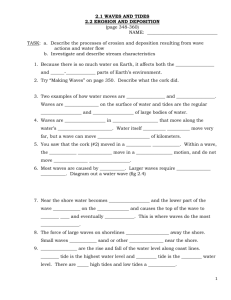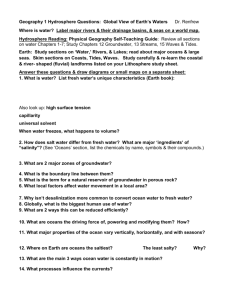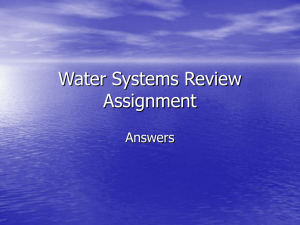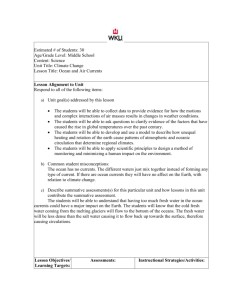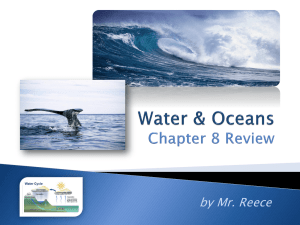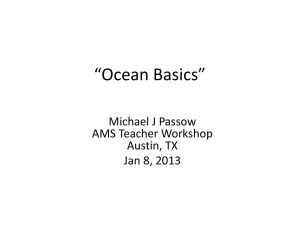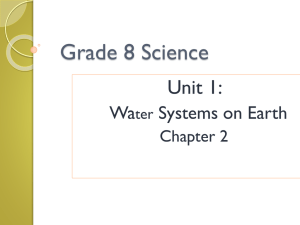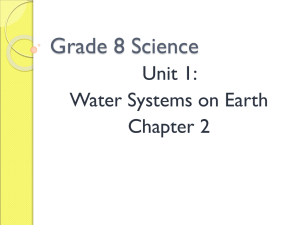Fresh and Saltwater Systems
advertisement
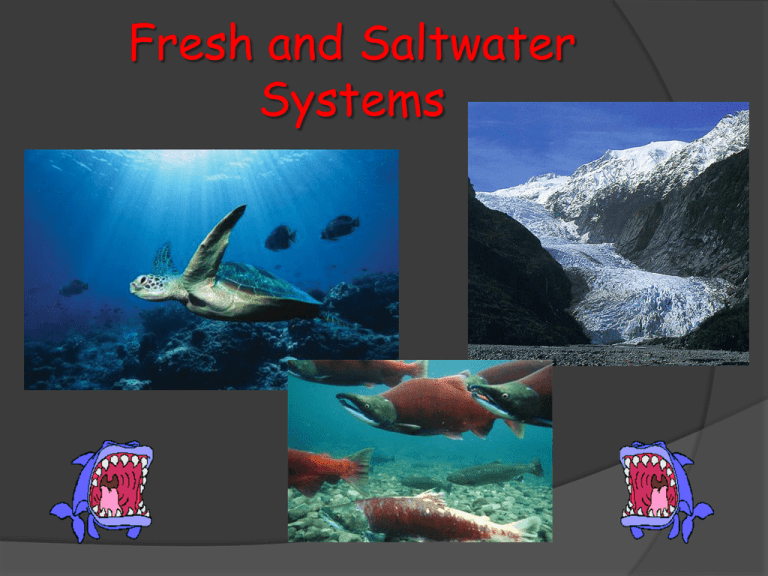
Fresh and Saltwater Systems Topic 1 – A World of Water How do we depend on water? • • • • • Cells in living organisms depend on water Ecosystems depend on water We depend on water for industry We depend on water for agriculture We depend on water for our living needs such as sewer and washing things Distribution of water on Earth Water Source Percentage of Water Oceans 97.20% Ice Caps and Glaciers 2.15% Groundwater 0.63% Rivers, Lakes, Soil and Atmosphere 0.02% TOTAL 100% Water enough for all? • Four countries share almost half of all the Earth’s fresh water Country Amount of Fresh Water Brazil 18% Canada 9% China 9% U.S.A 8% Other Countries 56% Topic 2 – Earth’s Frozen Water After ocean water, the next largest amount of water on Earth is frozen. What is a glacier • A large moving mass of ice and snow How do glaciers form 1. Snow flakes fall on ground and accumulate 2. Fallen flakes turn to snow grains over time 3. As snow keeps accumulating, pressure turns the snow grains to ice Types of Glaciers 1. Valley Glaciers – A glacier that forms in a mountain range. 2. Continental Glaciers – Occur mostly at the poles and are so thick that they bury mountain ranges. Glacial Features On your own...choose four of the following glacial features and give its definition as well as drawing a picture to show the feature. You will have about 15 minutes for this. • • • • • • • • Crevasse Cirques Arête Horn Moraine Esker Erratics U Shaped Valleys Glacial Features 1. Crevasse – A fissure or crack in the ice 2. Cirques – Bowl shaped basins in the mountains 3. Arête – A sharp ridge on a mountain 4. Horn – A sharpened peak on a mountain 5. Moraine – Ridge of material left behind by a moving glacier 6. Esker – A winding ridge left behind when a glacier melts 7. Erratics – Huge rock fragments left behind by glaciers 8. U Shaped Valley – Valleys eroded by glaciers that are U shaped Importance of Glaciers Take a look at page 384 and get four facts about why glaciers are important • • • • • • • Glaciers act as reservoirs of fresh water for drinking water Feed constant supply of water into rivers Helps run hydroelectric dams Used for irrigation of crops Provides fresh water for cattle ranchers Influence the water cycle Provide information about the Earth’s past climate Topic 3 – Fresh Water Systems • Fresh water systems exist as both above ground (surface water) and below ground (groundwater) Lakes, Ponds and Wetlands Lakes – Light does not reach the bottom of a lake Pond – Light reaches the bottom of a pond...ponds technically can be larger than a lake as long as light reaches the bottom Wetlands – These are saturated with water all or much of the time Streams and Rivers These are fast flowing waterways...streams however, are smaller than rivers Underground Water Most of the water that falls to Earth, sinks into the ground as ground water Watersheds Watersheds are areas of land that drains water into a body of water...rivers, lakes, ponds Watersheds in Alberta • Waterfall in central and northern areas flows towards the Arctic Ocean • East central and southern Alberta Hudson Bay • Southernmost area of Alberta Gulf of Mexico River Flow Monitoring River flow monitoring is important because: • It helps scientists to analyze water quality and to warn people about floods • Helps in predicting possible drought conditions • Helps in designing irrigation projects • Helps scientists to monitor sediment load in a river Why is Monitoring Sediment Important • • • • Some sediment released in fish habitat can carry toxins that can kill fish Too much sediment in rivers / lakes can decrease water depth making navigation by boat difficult or dangerous Sediment can affect delivery of water as sediment can wear out pumps and turbines Allows scientists to monitor affects of farming practices on the environment as some farming practices put sediments into water Groundwater Contamination Groundwater carries with it any contaminants that it encounters Contamination is put into two categories: 1. Point Sources – places where pollutants come from a small defined area Ex. Leaking gas tanks, leaking septic tanks, landfills 2. Non-point Sources – places where pollutants come from a large area Ex. Runoff from farmland YOU WILL NOW BE WORKING ON TOPIC 1 TO 3 REVIEW YOU MAY WORK WITH A PARTNER Topic 4 – The Oceans A Sea Full of Salt • Salt in the sea comes from groundwater that flows across rocks and minerals on land picking up the salt and then entering the sea. Ocean Waves • • Ocean waves start in the open ocean Waves are very similar to light waves we studied...they have a crest, trough and wavelength How Waves Change the Shoreline • Waves constantly move along shorelines and erode and redeposit sediments along the shore How Beaches are Formed • • • Waves carry sediments and fragments of rocks The sediments and rock fragments rub against each other and are smoothed into smaller pebbles and sometimes sand Beaches are constantly changing due to the constant action of waves Tides • Tides are the rise and fall of the ocean • Tidal movements occur due to the pull of the moon’s gravity on the ocean • Spring Tides are the largest tide changes and happen when the Earth, moon and sun are lined up • Neap Tides are small tide changes and happen when the moon is at right angles to the sun Ocean Currents Surface Currents – Surface currents are driven by the wind Three factors influence the direction of winds and surface currents: Winds begin as a result of uneven heating of Earth’s atmosphere 2. Rotation of the Earth causes a bending of the currents 3. Currents are forced to turn when the hit the continents 1. Warm and Cold Currents • • Warm currents flow from the equator and transfer heat to the atmosphere Cold currents flow from the poles and draw heat away from the atmosphere Topic 5 – Living in Water Adaptations for Aquatic Life Aquatic animals have many adaptations to live in water. They are: 1. 2. 3. 4. 5. 6. 7. They use gills to get oxygen from the water Some animals get their oxygen from the water’s surface Some animals such as dolphins have lungs to breathe Animals near shore have special appendages to help them dig in or stick to the ground Many water animals use buoyancy to help them move Many larger aquatic animals have streamlined bodies to help them move through the water Some aquatic animals filter their food out of the water Phytoplankton • • • Phytoplankton are microscopic plants Nearly all marine life depends on this plant to live They are also important to all life on Earth as they produce oxygen Nutrient Pollution • • • This happens when too many nutrients enter a water system The extra nutrients cause increase growth of algae As the algae dies, it falls to the bottom of the water and decomposes and decomposition uses up lots of oxygen that other animals need. Therefore other animals that need the oxygen can die.

